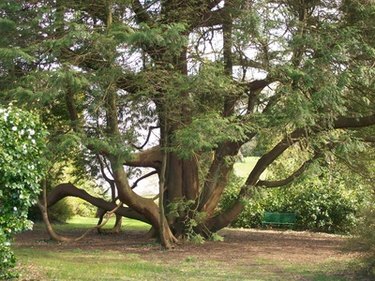
Cedar trees provide deep shade beneath their spreading branches–perfect for a garden nap, but not for gardeners wishing to plant beneath them. Few plants can survive the shade, dryness and acidic soil found under cedar trees, but there are some that can withstand such difficult conditions and even thrive.
Western Sword Fern
Video of the Day
Found naturally in the pine forests of the Pacific Northwest, western sword fern (Polystichum munitum) is one of the hardiest varieties of fern available. It thrives in acidic soil and deep shade, making it a good choice for beneath cedar trees–although it requires supplemental watering to reach its full potential. With dark-green, leathery foliage growing along arching fronds, western sword ferns form compact clumps that should be divided in the spring. They have a spreading habit that can quickly fill barren patches beneath established cedars, growing from 3 to 6 feet in height and with an equal spread.
Video of the Day
Long-leaf Oregon Grape
Long-leaf Oregon grape (Mahonia nervosa) has proven successful when planted beneath cedar trees due to its natural resistance to acidity and deep shade. It is an attractive evergreen shrub that is visually interesting throughout the year, bearing yellow flowers in spring, dark-blue berries in summer and claret-red foliage in autumn. Growing to 2 feet in height, long-leaf Oregon grape has long, upright stems with alternate lanceolate leaves and an open, airy habit. Unlike other plants suitable for planting beneath cedars, this species requires little supplemental water, thriving in the dry shade and indirect light.
Bear's Breeches
Bear's breeches (Acanthus mollis) is a large, highly ornamental plant native to areas around the Mediterranean. It is sometimes found growing wild in the cedar woods of Lebanon, where it thrives in the dry shade and acidic, well-draining soil of the forest floor. Grown for its dark-green, deeply lobed leaves, bear's breeches lends an eye-catching element to landscaping that might otherwise be lost in deep shade. It is a perennial, clumping plant that reaches 5 feet tall on average with 3-foot-long leaves. Although it does well in dry soil once established, young plants require slightly moist, loosened soil to send out new roots.
White Inside-Out Flower
Commonly planted in shade gardens, white inside-out flower (Vancouveria hexandra) is a semi-deciduous perennial plant that provides a delicate and beautiful ground cover in shady areas. It grows naturally in pine woods, so it does well in high acidity and dim light. Although it enjoys moderate moisture, soggy soil is damaging to its roots. White inside-out flower is a creeping plant with irregularly shaped leaves that resemble those of maidenhair fern but are slightly sturdier. Small white flowers emerge in spring, with swept-back petals and a nodding habit. The leaves and flower stems eventually reach 1 foot in height at maturity with a 3-foot or larger spread.